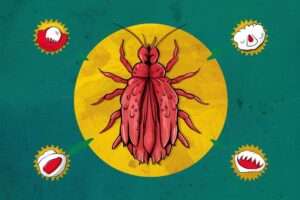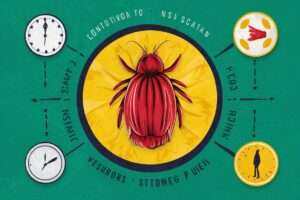Is Scabies an STD? Understanding the Facts About This Contagious Skin Condition
Scabies is a common and highly contagious skin infestation that affects millions of people worldwide. But is it really a sexually transmitted disease (STD)? This comprehensive guide will explore the nature of scabies, its transmission, symptoms, and treatment options, as well as clarify its relationship to STDs.
Anal STI Testing: A Comprehensive Guide to Protecting Your Sexual Health

Table of Contents
ToggleWhat Is Scabies?
Scabies is a skin infestation caused by tiny mites called Sarcoptes scabiei. These microscopic parasites burrow into the upper layer of the skin, where they live and lay eggs. This process leads to intense itching and a characteristic rash.
According to the World Health Organization (WHO), scabies affects more than 200 million people globally at any given time, making it a significant public health concern.
The State of Sex Education in America: Challenges and Progress

Is Scabies Considered an STD?
The short answer is no, scabies is not technically classified as a sexually transmitted disease. However, it can be transmitted through close skin-to-skin contact, including sexual activity. This misconception often leads people to wonder about its status as an STD.
Here’s why scabies is not considered an STD:
Understanding STD Incubation Periods: A Comprehensive Guide
1. Non-sexual transmission: Scabies can spread through various forms of non-sexual close contact.
2. Not limited to genital area: Unlike most STDs, scabies can affect any part of the body with skin.
3. Non-sexual risk factors: Factors unrelated to sexual activity, such as living in crowded conditions, can increase the risk of scabies.

How Is Scabies Transmitted?
Scabies spreads primarily through prolonged, close skin-to-skin contact. This can occur in various ways:
1. Sexual contact: Intimate skin-to-skin contact during sexual activity can transmit scabies.
2. Household contact: Living with or caring for someone with scabies can lead to transmission.
The Ultimate Guide to Condom Use: 15 Compelling Reasons to Wrap It Up
3. Institutional settings: Scabies outbreaks can occur in places like nursing homes, prisons, or childcare facilities.
4. Sharing personal items: While less common, sharing items like clothing or bedding with an infested person can sometimes spread scabies.
It’s important to note that casual contact, such as handshakes or hugs, typically doesn’t lead to scabies transmission. The mites need about 10 minutes of close contact to move from one person to another.

Symptoms of Scabies
Recognizing the symptoms of scabies is crucial for early detection and treatment. Common signs include:
1. Intense itching: This is often worse at night and is the most characteristic symptom of scabies.
2. Rash: A pimple-like rash appears in areas where the mites have burrowed.
3. Thin, irregular burrow tracks: These may be visible on the skin, often in warm areas like between fingers, under breasts, or in the genital area.
4. Sores: Scratching can lead to open sores, which may become infected.
5. Thick crusts: In severe cases, particularly in immunocompromised individuals, a more severe form called crusted scabies can develop.
Symptoms typically appear 2-6 weeks after infestation for first-time infections. However, if you’ve had scabies before, symptoms may appear within days of exposure.
Diagnosing Scabies
If you suspect you have scabies, it’s essential to seek medical attention. Diagnosis typically involves:
1. Physical examination: A healthcare provider will examine your skin for characteristic signs of scabies.
2. Microscopic examination: In some cases, a skin scraping may be examined under a microscope to identify mites, eggs, or fecal matter.
3. Dermatoscopy: This non-invasive technique uses a special microscope to examine the skin more closely.
Treatment Options for Scabies
Scabies is treatable with prescription medications. Common treatments include:
1. Permethrin cream: This is often the first-line treatment, applied to the entire body and washed off after 8-14 hours.
2. Ivermectin: An oral medication that may be prescribed in certain cases.
3. Other topical treatments: These may include crotamiton, lindane, or sulfur ointments.
It’s crucial to follow treatment instructions carefully and treat all household members and close contacts simultaneously to prevent reinfestation.
Preventing Scabies
While scabies can affect anyone, certain preventive measures can reduce your risk:
1. Avoid close contact with infested individuals.
2. Wash clothing, bedding, and towels used by infested persons in hot water and dry on high heat.
3. Seal items that can’t be washed in plastic bags for at least 72 hours.
4. Vacuum your home thoroughly and dispose of the vacuum bag.
5. Seek prompt treatment if you suspect exposure to scabies.
Scabies vs. Other Skin Conditions
Scabies can sometimes be confused with other skin conditions. Here’s how it differs from some common ones:
1. Eczema: While both cause itching, eczema doesn’t involve mites and often has a different distribution on the body.
2. Dermatitis: Various forms of dermatitis can cause itching and rashes but lack the characteristic burrows of scabies.
3. Bed bugs: These cause itchy bites but don’t burrow into the skin like scabies mites.
4. Allergic reactions: These can cause itching and rashes but typically have a known trigger and don’t spread to others.
When to Seek Medical Help?
You should consult a healthcare provider if:
– You suspect you have scabies
– You’ve been in close contact with someone diagnosed with scabies
– Your symptoms persist after treatment
– You develop signs of a secondary bacterial infection, such as fever or pus-filled sores
Conclusion
While scabies can be transmitted through sexual contact, it’s not classified as an STD due to its various non-sexual transmission routes. Understanding the facts about scabies, including its symptoms, transmission, and treatment options, is crucial for early detection and effective management of this common skin condition. Remember, prompt treatment not only relieves your symptoms but also prevents the spread to others.
Reference to External Sources:
[1] https://www.who.int/news-room/fact-sheets/detail/scabies
[2] https://www.cdc.gov/parasites/scabies/index.html
[3] https://www.aad.org/public/diseases/a-z/scabies-overview
[4] https://www.ncbi.nlm.nih.gov/books/NBK544306/


